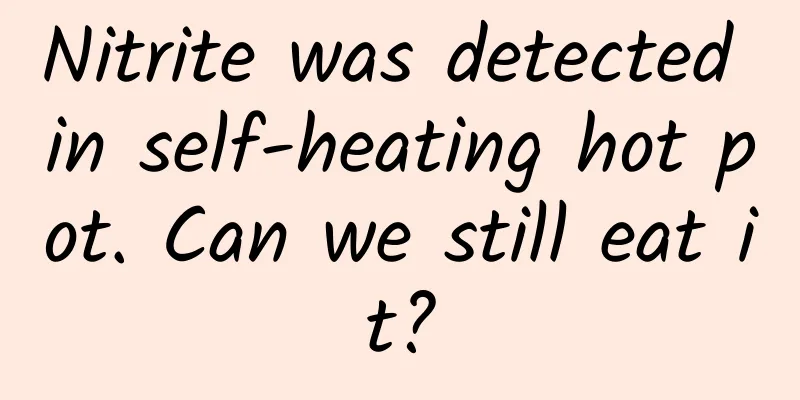Nitrite was detected in self-heating hot pot. Can we still eat it?

|
Recently, Consumer Reports sent 10 self-heating hot pots to an authoritative third-party testing agency for testing. The results showed that all of them contained nitrite, and 5 of them contained suspected carcinogens (3-MCPD). As soon as this report came out, it attracted widespread attention. Is it still okay to eat self-heating hot pots? What are suspected carcinogens? Suspected carcinogens refer to substances that have the potential to cause cancer in humans or whose carcinogenicity is uncertain. The suspected carcinogen 3-MCPD mentioned in the report is trichloropropane, a food contaminant that was first found in acid-hydrolyzed vegetable protein and soy sauce, and later in other foods. Fat-containing raw materials such as soybeans will break down and hydrolyze into glycerol under the action of strong acid, and glycerol will generate trichloropropane under strong acid or high temperature conditions. Relevant studies have shown that long-term excessive intake of trichloropropane may cause damage to the human reproductive system and kidney function. At present, my country's national standard stipulates that the limit of trichloropropane in liquid condiments is 0.4mg/kg. The highest amount in the test report is 0.023mg/kg, which does not exceed the limit, so there is no need to panic. Why is nitrite detected? As mentioned before, nitrite is commonly found in all plants. Generally, the content in fresh vegetables is low (less than 4 mg/kg), but the nitrite content will increase as the storage time increases. In addition, nitrite is allowed to be used as a food additive (preservative, colorant) in meat products. Therefore, it is normal to detect nitrite in self-heating hot pot. Can I still eat self-heating hot pot? According to my country's food safety standards, the residual amount of nitrite in meat products is between 30 and 70 mg/kg, and the nitrite content in vegetables and their products should be less than 20 mg/kg. The maximum amount of nitrite in the test report was 7.95 mg/kg, which neither exceeded the limit standard in meat products nor the limit standard in vegetable products. Although nitrite is toxic, you need to eat hundreds of milligrams at a time to have a poisoning reaction, so if you want to eat self-heating hot pot, it is still okay. However, you should pay attention to the limited vegetables in the self-heating hot pot, and they are not fresh. If conditions permit, you can add some vegetables that are easy to cook or can be eaten raw (cucumbers, green leafy vegetables, tomatoes, etc.). Moreover, fresh vegetables contain antioxidants such as vitamin C, which can prevent some nitrites from forming carcinogenic nitrosamines. Therefore, adding some fresh vegetables can not only reduce concerns about nitrites, but also improve nutritional balance. |
>>: Q&A | Too much water can put out a fire, but can a big fire ignite the water?
Recommend
If you lose your teeth, you can use medicine to grow them back. This new research may benefit many people in the future.
Maybe the teeth that fall out can grow back in th...
You have definitely never seen a “penguin with long legs”!
The Palace Museum published the "Illustrated...
JD.com physical crowdfunding project: more than 200 projects raised over 250 million yuan, practical operation and case analysis
JD.com physical crowdfunding project: more than 2...
Mercedes-Benz sold 57,700 vehicles in China in April, setting a new sales record for the same period in history
The Xi'an Mercedes-Benz oil leak incident not...
Zhihu Monetization: Does the gene for selling goods equal the ability to sell goods?
The commercialization issue of Zhihu has always b...
Baidu buys Kuaiqian for RMB 2 billion: a good deal for a man and a woman
After Double Eleven, Baidu also started the “buy,...
After negotiations with Mercedes-Benz and BMW failed, Apple reportedly reached an agreement with Volkswagen on autonomous driving transformation
Apple has continued to advance its self-driving c...
Watch industry executives: Smart watches are too ugly
Apple has hired Patrick Pruniaux, vice president o...
#千万IP创科学热门#丨Minnan flower bricks, can cement also bloom?
Minnan tiles are traditional architectural decora...
Learn Photoshop from scratch, 18 lessons to go from a novice to a master
Learn Photoshop from scratch, from beginner to ma...
The dunes are all wavy? Is this a bug?
Audit expert: Zhan Mingjin PhD, Chinese Academy o...
Which industries are suitable for the Qutoutiao platform? July advertising overview
Qutoutiao focuses on "light reading", f...
Do insects have emotions?
© BBC/Alamy Leviathan Press: Personally, the ques...
Did we domesticate cats, or did cats domesticate us?
This year is the Year of the Tiger. So let’s talk...
Divergence or coexistence? A detailed explanation of Android kernel security
1. Knowledge Background In October 2003, Andy Rub...






![[Creative Cultivation Program] The mystery of the origin of mitochondria: How was the energy factory of eukaryotic cells built?](/upload/images/67f25b3c53b12.webp)


